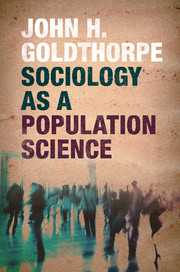Book contents
- Frontmatter
- Dedication
- Contents
- Acknowledgements
- Introduction
- 1 Sociology as a population science: the central idea
- 2 Individual variability in human social life
- 3 The individualistic paradigm
- 4 Population regularities as basic explananda
- 5 Statistics, concepts and the objects of sociological study
- 6 Statistics and methods of data collection
- 7 Statistics and methods of data analysis
- 8 The limits of statistics: causal explanation
- 9 Causal explanation through social mechanisms
- Conclusion
- References
- Index
9 - Causal explanation through social mechanisms
Published online by Cambridge University Press: 05 December 2015
- Frontmatter
- Dedication
- Contents
- Acknowledgements
- Introduction
- 1 Sociology as a population science: the central idea
- 2 Individual variability in human social life
- 3 The individualistic paradigm
- 4 Population regularities as basic explananda
- 5 Statistics, concepts and the objects of sociological study
- 6 Statistics and methods of data collection
- 7 Statistics and methods of data analysis
- 8 The limits of statistics: causal explanation
- 9 Causal explanation through social mechanisms
- Conclusion
- References
- Index
Summary
In order to provide causal explanations for established population regularities, causal processes, or mechanisms, must be hypothesized in terms of individual action and interaction that meet two requirements: they should be in principle adequate to generate the regularities in question and their actual operation should be open to empirical test. Advantage lies with mechanisms explicitly specified in terms of action that is in some sense rational.
Until well into the twentieth century, it was the standard view that causal explanations in science were arrived at by showing how observed phenomena followed from the operation of some general ‘covering’ law of a deterministic kind (see e.g. Hempel, 1965). And this view does indeed in various quarters persist. However, with the probabilistic revolution, as discussed in Chapter 1, the idea of causal explanation as being dependent on the existence of deterministic laws was called into question, and in the more recent past a significantly different idea of the nature of such explanation has emerged and gained in acceptance. This is, in brief, the idea that causal explanations entail the spelling out, as fully as possible, of just how – through what continuous space–time processes or mechanisms – a supposed cause actually produces its effect (for extensive discussion from the standpoint of the philosophy of science, see Illari, Russo and Williamson, 2011).
Proponents of what could be called ‘mechanism-based causal explanation’ recognise that, from field to field, the nature of the mechanisms that will need to be envisaged and the ways in which they will be specified, in terms of the entities involved and their causal capacities, will vary widely. It may be recalled that Neyman – who can be regarded as an early adherent of the idea of mechanism-based explanation – emphasised that the mechanisms to be invoked in a population science in order to explain aggregate-level probabilistic regularities would be ones that, rather than being deterministic and applying to every individual case, themselves ‘incorporated chance’. And in sociology understood as a population science, it would further seem clear that the key entities of such mechanisms must be individuals and that causal capacity must be taken to lie in the action of individuals and, ultimately, in the degree of autonomy that, through the possibility of informed choice, such action possesses (see Chapter 3).
- Type
- Chapter
- Information
- Sociology as a Population Science , pp. 112 - 125Publisher: Cambridge University PressPrint publication year: 2015



